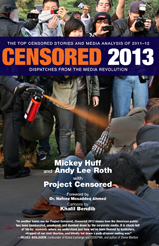Censorship without the Censors
Censored 2013:
Dispatches from the Media Revolution
by Mickey Huff and Andy Lee Roth
with Project Censored
Seven Stories Press, 2012,
464 pp. $14.96

Censored 2013: Dispatches from the Media Revolution is a crucial book on the top censored news stories of 2011-2012 that were ignored or underreported by the mainstream media. This book, the latest installment in a series, is a useful tool for all social movement organizers and for media activists in particular.
Censored 2013 begins with a meticulously curated list of the top 25 censored stories of 2011-2012. Examples include “HR 347 would make many forms of protest illegal,” “the international year of cooperatives, and “members of Congress grow wealthier despite recession.” These 25 stories are all grouped into five “censored news clusters” that are structured to provide analytic connections across stories. The clusters in the 2013 edition are: the police state and civil liberties; news we can use to create a U.S. economy for the 99 percent; environment and health; human cost of war and violence; and women, gender, race, and ethnicity.
Each of the individual stories is given a brief outline, meant to ever so slightly rectify their censorship in the mainstream media. Following this, the authors revisit some of the top censored stories from previous years, focusing on the extent to which they have either become part of public discourse or yet remain censored. They then glide from this to a more concerted focus on the opposition, with a scathing critique of some of the most common and often unnoticed tactics of the mass media. These tactics include the constant barrage of “junk news” — stories that have no real relevance to the lives of the general public — and the predominance of government officials as quoted sources, without challenge or comment.
Beyond the list of censored stories from the past year, the most significant contribution of Censored 2013 is its exhortation to rethink and think beyond what we traditionally think of as “censorship.” While direct interference from the government is of course relevant to any discussion of censorship, in our age of complicit mass media, this definition alone is not sufficient. Instead, Huff and Roth define censorship as “a form of propaganda — deceptive communication used to influence public opinion to benefit a special interest.” Or more succinctly, any media purporting to be news that is “based on anything other than a desire to tell the truth.”
While this may seem almost too broad a definition to be functional, it in fact opens up space to rethink how we view the media and give us as activists a new position from which to attack and, hopefully, replace the mainstream media. Recent Pew media polls conclude that “negative opinions about the performance of news organizations now equal or surpass all-time highs on nine of the 12 core measures the Pew Research Center has been tracking since 1985.” Furthermore, 61% of people polled in February 2012 believed the media actually has a “negative effect” on “the way things are going in this country.” At a time when consumers of U.S. news media trust mainstream sources less than ever, Censored 2013 is as critical as it is timely.



